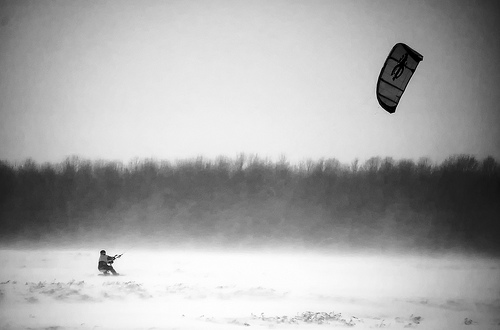This guide was created by Dmitri Maramenides, a professional kiteboarder that rides for Epic Kites. Scroll to the bottom of this post to learn more about Dmitri and his passion for the sport of kiteboarding.
Learn How to Kiteboard
Kiteboarding is one of the fastest growing sports – with riders boosting huge airs, riding rails or cruising on surfboards, there is something for everyone with this wind addiction. Once you have been bitten by the bug, the next question is: How do I even begin and where can I find out more? Don’t worry. I’m here to help.
Get Schooled
While kiteboarding is a spectacular activity, it’s not a sport that you can pick up and practice right away. It takes time and, like any sport, you get out what you put in. Your first goal should be to start learning about the sport through asking kiteboarders at your local spot, visiting websites and looking through magazines. The common denominator in all of this information is to begin with taking a lesson from a qualified instructor. Kiteboarding schools are popping up all over the place, so give one a call and get familiar with their lesson plan, process and practices.

Most facilities will offer several lesson plans ranging from an intro land lesson all the way to advanced training with tricks and high altitude boosting. An introductory lesson will give you all the essentials so that you can safely practice on your own. In your lesson you will learn about the wind window, safe site selection, trainer kite flying, kite control, safety systems, large kite rigging, launching/landing, control, body dragging, board starts and the all-important self rescue. As you can see, there are a lot of steps in this process, and the best way to proceed is to go back after your lesson and practice each step until you are comfortable and confident.
Kiteboarding is not something you want to attempt on your own with no guidance or support. Kites have loads of power and if used improperly will result in serious injury; but with the proper education, knowledge and practice, you’ll soon be enjoying some pretty amazing sessions!
Kiteboarding 101: Breaking it Down
Flying a power kite is a little different than the toy kites we flew as kids, but the fundamentals are the same. With the wind at your back, the wind window dictates kite position, power and orientation to the land. Think of the window like the top half of a clock with 12 being above your head. On the right hand side we have 11, 10 and 9 o’clock locations. The edge or the wind window is parallel to your shoulders and will create the least amount of pull. With the kite in the right hemisphere of this window, you’ll travel to the right. The reverse happens on the left hand side. Dive the kite hard, and you’ll experience ‘the power zone’. If the lowest amount of power is at the edge of the window (in line with your shoulders) the power increases as you move the kite more in front of your body. Try a small trainer kite to practice hitting these wind window locations and gain expert control before moving to the larger kites. You should be able to fly this trainer with one hand while making a phone call!

After your lesson and expert trainer kite control, it’s time to practice flying the larger kite for your first few beach sessions. Remember, pick a suitable location and have a total understanding of how the wind direction relates to that spot. Once your kite is rigged, ask a qualified person to launch your kite and then move into the water. Thigh to waist deep water works best here. Forget about the board for this control experience. Practice flying your kite in control and learn to anticipate what it does. An experienced rider will know how the kite behaves when there are changes in the wind and how to react. Learn to read the kite and the conditions. After being a competent flyer, practice body dragging. This is where things start to come together and become real fun. By moving the kite in control through the power zone, you’ll drag through the water and learn how the kite and you behave when moving. You’ll crash the kite a number of times but having the skill to relaunch is paramount. And with today’s modern kites like the Epic Renegade, launching is a cinch!
When you return to the beach, it’s now time to bring the board into the equation. With your kite at 12 o’clock, sit in the water with your board in one hand and practice putting your feet in the straps and then removing the board. What you’ll find here is that the kite will always want to pull you forward, making this exercise challenging. It’s just a new feel. I always promote baby steps here as it will pay off in the long run. Now that you can get in and out of the board, you’ll want to start learning how to get on it and ride. Breaking this down is easy. When you have your feet in the straps and the kite at 12, I suggest doing a small power stroke just to give you a feel for what is about to happen. Most times you’ll find that you end up backwards and disoriented. To keep facing frontwards, use your feet to resist against the kite and your hands to paddle. Again, do a few more small strokes and you’ll feel that the kite wants to pull you up on the board. When you’re ready, do a larger power stroke and roll up onto your heels. You’re riding! Although your first few starts might be brief, in no time you’ll be travelling in one direction for several hundred feet. When you crash and lose the board, recall your body dragging experience and retrieve it. Most importantly after a crash… relax, stay calm, collect yourself and go again.
Kiteboarding Safety
Kite safety is everyone’s responsibility and is not to be overlooked. A stray kite poses a risk to other people enjoying the beach and might injure someone. As a kiteboarder it is your responsibility to manage the safety of yourself as well as others around you. A great way to get familiar with your safety systems is to go to a local park, tie your lines off to a post and practice the release system. Modern kites have 4 safety systems:
- Simply let go of the bar and depower the kite.
- Use the depower straps on the kite. A rule of thumb is that if you’re riding with the depower strap pulled all the way out, you’re on too big of a kite.
- Engage the quick release which will ensure the kite luffs to the water with little pull. This system can be reset in the water so your session can continue.
- If things go bad and you cannot control the kite, get rid of it by pulling the leash safety. Note that this will result in a stray kite, but your life is not worth potential equipment loss or damage.
Know these systems inside and out as you might only get one shot to engage them. Having said that, if you’re safe in your site selection, rigging and kite control, you’ll have little need for them.
Moving Forward
As mentioned above, your first few times at the beach should be spent practicing your skills and taking short, controlled rides. After these first few sessions, you’ll notice how quickly you improve. You’ll be focusing more on where you’re riding rather than looking at the kite and generally get more excited with each time out. As skills improve, you’ll want to add some directional changes and tricks to your bag. The learning curve is steep but each time you come out of the water you’ll be thrilled at your progression.
Kiteboarding can be enjoying on the water, in the snow, on a land board, skis, skateboards, buggy, hyrdo board… you get it. If you’re reading this, you’re curious and interested. So what are you waiting for? Contact a local school and get moving! See you at the beach!
Brian Ready for example, is an instructor in Ontario, Canada teaching on both water and snow.
Dmitri Maramenides was born in Greece and raised in Greece, Cameroon and France. While he windsurfed professionally for 22 years, he started kiteboarding in the United States in April, 2000. He currently lives in North Carolina. You can learn more about Dmitri and his kiteboarding expertise at Epic Kites.
[images via dmdzine and Waechor]
- An Anatomically Correct Nut Tool for Climbers - 5 June, 2015
- Obstacle Race Training Guide - 4 June, 2015
- Using Night Vision in Extreme Sports - 25 March, 2015


Trackbacks